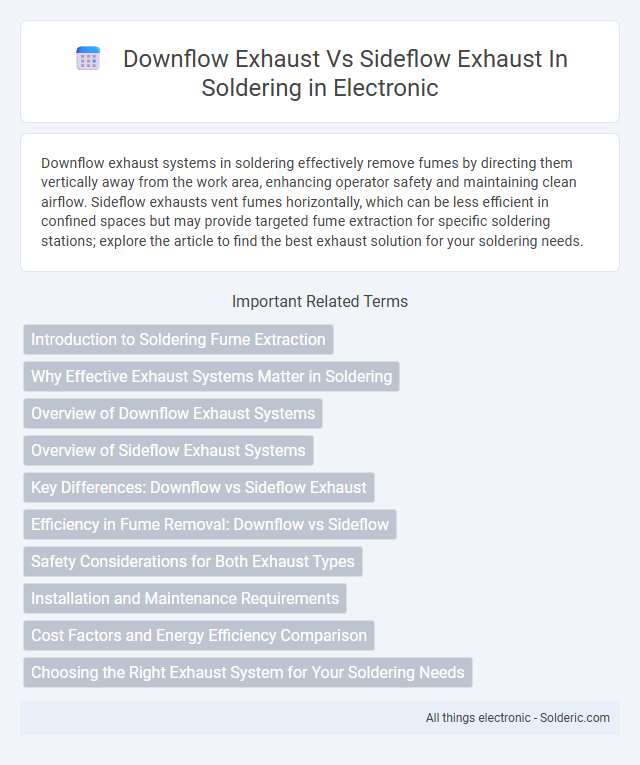Downflow exhaust systems in soldering effectively remove fumes by directing them vertically away from the work area, enhancing operator safety and maintaining clean airflow. Sideflow exhausts vent fumes horizontally, which can be less efficient in confined spaces but may provide targeted fume extraction for specific soldering stations; explore the article to find the best exhaust solution for your soldering needs.
Comparison Table
| Feature | Downflow Exhaust | Sideflow Exhaust |
|---|---|---|
| Airflow Direction | Vertically downward | Horizontally sideways |
| Fume Collection Efficiency | High efficiency near soldering point | Moderate efficiency, may disperse fumes |
| Workspace Accessibility | Unobstructed workspace above exhaust | May restrict side access due to ducting |
| Installation Complexity | Simple vertical ducting | Requires horizontal duct connections |
| Common Applications | Benchtop soldering stations, precision work | Industrial lines, larger soldering setups |
| Noise Levels | Lower noise due to vertical exhaust path | Higher noise from lateral air movement |
| Maintenance | Easy filter replacement and cleaning | More complex due to duct routing |
Introduction to Soldering Fume Extraction
Downflow exhaust systems in soldering extract fumes by pulling contaminants downward, improving operator safety and maintaining clean workspace air. Sideflow exhaust systems remove soldering fumes laterally, offering localized extraction ideal for bench setups with limited overhead clearance. Effective soldering fume extraction minimizes exposure to harmful flux gases and particulate matter, ensuring compliance with industrial safety standards.
Why Effective Exhaust Systems Matter in Soldering
Effective exhaust systems in soldering are crucial for maintaining air quality and protecting workers from harmful fumes generated during the soldering process. Downflow exhaust systems efficiently capture fumes directly at the source by drawing air downward, preventing the spread of hazardous particles, while sideflow exhaust systems remove contaminants from the side, which may be less effective in tight spaces or when fumes rise. Optimizing exhaust direction and airflow ensures a safer work environment, reduces respiratory risks, and enhances compliance with occupational health standards.
Overview of Downflow Exhaust Systems
Downflow exhaust systems in soldering operate by directing contaminated air vertically downward away from the work area, effectively capturing fumes at the source. These systems utilize high-efficiency particulate air (HEPA) filters and activated carbon filters to remove flux fumes and hazardous particles, ensuring a cleaner and safer environment. Downflow exhaust is particularly beneficial in compact soldering stations where space constraints require efficient vertical airflow management.
Overview of Sideflow Exhaust Systems
Sideflow exhaust systems in soldering capture fumes horizontally at the side of the work area, efficiently removing hazardous soldering smoke and particulate matter. These systems typically feature adjustable hoods or ducts allowing localized extraction close to the soldering point, minimizing operator exposure. Sideflow exhaust solutions are preferred in compact workspaces where vertical space is limited or specific directional airflow control is required.
Key Differences: Downflow vs Sideflow Exhaust
Downflow exhaust systems direct fumes vertically downward away from the soldering area, ensuring efficient removal of hazardous particles and better protection for your respiratory health. Sideflow exhausts draw fumes horizontally from the sides, which can be less effective in capturing all contaminants and may spread fumes across the workspace. Choosing the right exhaust type impacts air quality and worker safety in soldering environments.
Efficiency in Fume Removal: Downflow vs Sideflow
Downflow exhaust systems in soldering provide higher efficiency in fume removal by directing fumes vertically downward immediately at the source, minimizing exposure and preventing dispersion into the operator's breathing zone. Sideflow exhausts capture fumes laterally, which can lead to less efficient fume extraction and increased risk of inhalation due to turbulence and mixing with ambient air. Studies show downflow systems reduce hazardous soldering fume concentration by up to 35% more than sideflow units, improving workplace air quality and safety.
Safety Considerations for Both Exhaust Types
Downflow exhaust systems direct fumes and contaminants away from the worker's breathing zone by pushing airflow vertically downward, reducing inhalation risks in soldering environments. Sideflow exhausts capture and remove soldering fumes horizontally, which can be effective but may require careful placement to prevent exposure and ensure proper ventilation. Your safety depends on consistent maintenance and correct positioning of either system to minimize toxic fume exposure during soldering processes.
Installation and Maintenance Requirements
Downflow exhaust systems in soldering require ceiling or overhead installation with ductwork designed to channel fumes downward, demanding precise placement for effective smoke capture and complicating accessibility for maintenance. Sideflow exhaust systems mount perpendicular to the work surface, often at workstation level, allowing easier access for filter replacement and cleaning but may require additional space allocation on the soldering bench. Both systems need routine filter checks and duct inspections to maintain optimal fume extraction efficiency and comply with occupational safety standards.
Cost Factors and Energy Efficiency Comparison
Downflow exhaust systems generally have higher upfront costs due to complex ducting and stronger fans but offer superior energy efficiency by directing fumes downward, optimizing airflow and reducing heat loss. Sideflow exhaust units tend to be more cost-effective initially with simpler design and installation but may consume more energy as they require larger fans to maintain effective fume extraction. Your choice should balance budget constraints with long-term energy savings, considering the operational environment and frequency of use.
Choosing the Right Exhaust System for Your Soldering Needs
Selecting the right exhaust system for your soldering needs depends on workspace layout and contaminant control effectiveness. Downflow exhaust systems efficiently capture fumes directly above the soldering area, minimizing exposure to harmful particulates, while sideflow exhausts offer greater flexibility for varied workstation configurations. You should consider the specific ventilation requirements and the type of soldering process to optimize safety and air quality.
Downflow exhaust vs sideflow exhaust in soldering Infographic

 solderic.com
solderic.com